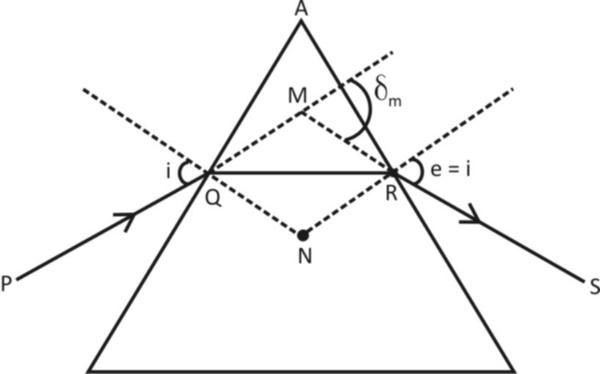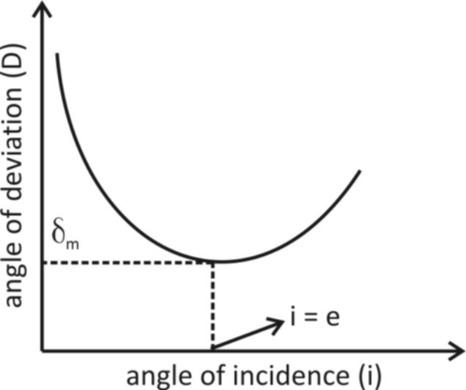
Draw a ray diagram to show the refraction of a monochromatic ray through a prism when it suffers minimum deviation.
Answer
567.3k+ views
Hint: As we all know when a light deviates with a minimum amount after refraction through the prism, angle of incidence (i) and the angle of emergence (e) are equal.
Complete step by step answer:

The above diagram shows the path of light traced when it passes through a prism such that the angle of deviation of light is minimum.
We know that deviation angle, $\delta $is given by
$\delta = i + e - A$
Where $i$ is the angle of incidence
$e$ is the emergent angle
$A$ is the angle of prism.
Thus, the angle of deviation depends upon the angle of incidence. A plot between angle of deviation and angle of incidence is shown below from where it is clear that corresponding to$i = e$, $\delta $is minimum and for all other values of $i$, there are two values of $\delta $.
So, at minimum deviation$i - e$.
$\delta = \delta m,{\text{ i}} = e$

When a light deviates with a minimum amount, the angle of incidence and the angle of emergence are equal.
Also, the light inside the prism passes parallel to the base of prism BC.
Note:
If a ray enters the prism from air with a refractive index \[{n_1} = 1\], the direction of the ray after it passes through the prism will depend only on its apex angle Q and the refractive index n of the glass from which prism is made. Passage of a ray through an optical prism is depicted in the picture above.
Complete step by step answer:

The above diagram shows the path of light traced when it passes through a prism such that the angle of deviation of light is minimum.
We know that deviation angle, $\delta $is given by
$\delta = i + e - A$
Where $i$ is the angle of incidence
$e$ is the emergent angle
$A$ is the angle of prism.
Thus, the angle of deviation depends upon the angle of incidence. A plot between angle of deviation and angle of incidence is shown below from where it is clear that corresponding to$i = e$, $\delta $is minimum and for all other values of $i$, there are two values of $\delta $.
So, at minimum deviation$i - e$.
$\delta = \delta m,{\text{ i}} = e$

When a light deviates with a minimum amount, the angle of incidence and the angle of emergence are equal.
Also, the light inside the prism passes parallel to the base of prism BC.
Note:
If a ray enters the prism from air with a refractive index \[{n_1} = 1\], the direction of the ray after it passes through the prism will depend only on its apex angle Q and the refractive index n of the glass from which prism is made. Passage of a ray through an optical prism is depicted in the picture above.
Recently Updated Pages
Master Class 12 Business Studies: Engaging Questions & Answers for Success

Master Class 12 Economics: Engaging Questions & Answers for Success

Master Class 12 English: Engaging Questions & Answers for Success

Master Class 12 Maths: Engaging Questions & Answers for Success

Master Class 12 Social Science: Engaging Questions & Answers for Success

Master Class 12 Chemistry: Engaging Questions & Answers for Success

Trending doubts
What are the major means of transport Explain each class 12 social science CBSE

Which are the Top 10 Largest Countries of the World?

Draw a labelled sketch of the human eye class 12 physics CBSE

How much time does it take to bleed after eating p class 12 biology CBSE

Explain sex determination in humans with line diag class 12 biology CBSE

Differentiate between homogeneous and heterogeneous class 12 chemistry CBSE




